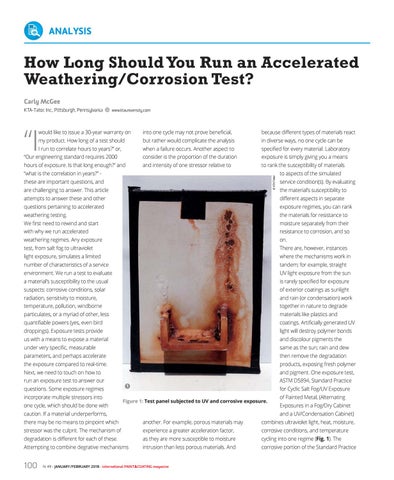ANALYSIS
How Long Should You Run an Accelerated Weathering/Corrosion Test? Carly McGee KTA-Tator, Inc., Pittsburgh, Pennsylvania
www.ktauniversity.com
“I
would like to issue a 30-year warranty on
into one cycle may not prove beneficial,
because different types of materials react
my product. How long of a test should
but rather would complicate the analysis
in diverse ways, no one cycle can be
I run to correlate hours to years?” or,
when a failure occurs. Another aspect to
specified for every material. Laboratory
“Our engineering standard requires 2000
consider is the proportion of the duration
exposure is simply giving you a means
hours of exposure. Is that long enough?” and
and intensity of one stressor relative to
to rank the susceptibility of materials © KTA-Tator
“what is the correlation in years?” these are important questions, and are challenging to answer. This article
to aspects of the simulated service condition(s). By evaluating the material’s susceptibility to
attempts to answer these and other
different aspects in separate
questions pertaining to accelerated
exposure regimes, you can rank
weathering testing.
the materials for resistance to
We first need to rewind and start
moisture separately from their
with why we run accelerated
resistance to corrosion, and so
weathering regimes. Any exposure
on.
test, from salt fog to ultraviolet
There are, however, instances
light exposure, simulates a limited
where the mechanisms work in
number of characteristics of a service
tandem; for example, straight
environment. We run a test to evaluate
UV light exposure from the sun
a material’s susceptibility to the usual
is rarely specified for exposure
suspects: corrosive conditions, solar
of exterior coatings as sunlight
radiation, sensitivity to moisture,
and rain (or condensation) work
temperature, pollution, windborne
together in nature to degrade
particulates, or a myriad of other, less
materials like plastics and
quantifiable powers (yes, even bird
coatings. Artificially generated UV
droppings). Exposure tests provide
light will destroy polymer bonds
us with a means to expose a material
and discolour pigments the
under very specific, measurable
same as the sun; rain and dew
parameters, and perhaps accelerate
then remove the degradation
the exposure compared to real-time.
products, exposing fresh polymer
Next, we need to touch on how to
and pigment. One exposure test,
run an exposure test to answer our questions. Some exposure regimes incorporate multiple stressors into one cycle, which should be done with
ASTM D5894, Standard Practice
1
for Cyclic Salt Fog/UV Exposure
Figure 1: Test panel subjected to UV and corrosive exposure.
of Painted Metal, (Alternating Exposures in a Fog/Dry Cabinet and a UV/Condensation Cabinet)
caution. If a material underperforms, there may be no means to pinpoint which
another. For example, porous materials may
combines ultraviolet light, heat, moisture,
stressor was the culprit. The mechanism of
experience a greater acceleration factor,
corrosive conditions, and temperature
degradation is different for each of these.
as they are more susceptible to moisture
cycling into one regime (Fig. 1). The
Attempting to combine degrative mechanisms
intrusion than less porous materials. And
corrosive portion of the Standard Practice
100
N. 49 - JANUARY/FEBRUARY 2018 - international PAINT&COATING magazine
